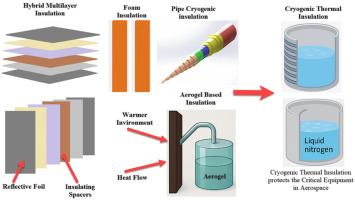低温应用隔热创新技术的进展
IF 9.4
1区 工程技术
Q1 ENERGY & FUELS
引用次数: 0
摘要
低温材料隔热技术的发展对电子冷却至关重要。本文综述了电子制冷领域低温绝热技术的研究进展,包括多层绝热(MLI)、真空绝热板(VIPs)、蒸汽压缩系统(VCS)和气溶胶等,以展示多层绝热技术的优越性,并为今后的高效绝热研究奠定基础。这些发展保证了更少的热量传递,并加强了对过热的控制。本文的主要内容是对保温材料的研究,使其在实际应用中更加有效。本文汇编了保温方法的重要进展,并进行了全面的分析。它主要取代了电子冷却的使用,电子冷却通过使用液氮或氦将电子元件冷却到极低的温度来减少高性能计算和量子电子学中的电阻。MLI提供了最有效的隔热材料。本文的目的是为未来的隔热研究奠定基础,重点研究其在低温下的性能和要求。人们认识到,不同的应用对每种方法有不同的需要;因此,开发一种更有效的绝缘方法是有空间的。本文章由计算机程序翻译,如有差异,请以英文原文为准。

Progress in innovative technologies in thermal insulation for cryogenic applications
Technological developments for thermal insulation in cryogenic materials are crucial for electronic cooling. This review paper compiles advancements in cryogenic thermal insulation technologies for electronic cooling, including multilayer insulation (MLI), vacuum insulation panels (VIPs), vapor compression systems (VCS) and aerosols, in order to demonstrate the superiority of MLI and to establish the groundwork for future high-efficiency insulation research. These developments guarantee less heat transmission and enhance the control of overheating. The research of thermal insulation, which can be further effective with its application, is the main subject of this review paper. The paper compiles important developments in thermal insulation methods and offers a thorough analysis. It primarily replaces the use of electronic cooling, which reduces electrical resistance in high-performance computing and quantum electronics by chilling electronic components to extremely low temperatures using liquid nitrogen or helium. The MLI offers the most effective thermal insulation. The goal of the review paper is to lay the groundwork for future research on thermal insulation, with an emphasis on its performance and requirements at cryogenic temperatures. It is recognized that different applications have different needs for each methodology; thus, there is room to develop a more effective insulating method.
求助全文
通过发布文献求助,成功后即可免费获取论文全文。
去求助
来源期刊

Energy
工程技术-能源与燃料
CiteScore
15.30
自引率
14.40%
发文量
0
审稿时长
14.2 weeks
期刊介绍:
Energy is a multidisciplinary, international journal that publishes research and analysis in the field of energy engineering. Our aim is to become a leading peer-reviewed platform and a trusted source of information for energy-related topics.
The journal covers a range of areas including mechanical engineering, thermal sciences, and energy analysis. We are particularly interested in research on energy modelling, prediction, integrated energy systems, planning, and management.
Additionally, we welcome papers on energy conservation, efficiency, biomass and bioenergy, renewable energy, electricity supply and demand, energy storage, buildings, and economic and policy issues. These topics should align with our broader multidisciplinary focus.
 求助内容:
求助内容: 应助结果提醒方式:
应助结果提醒方式:


